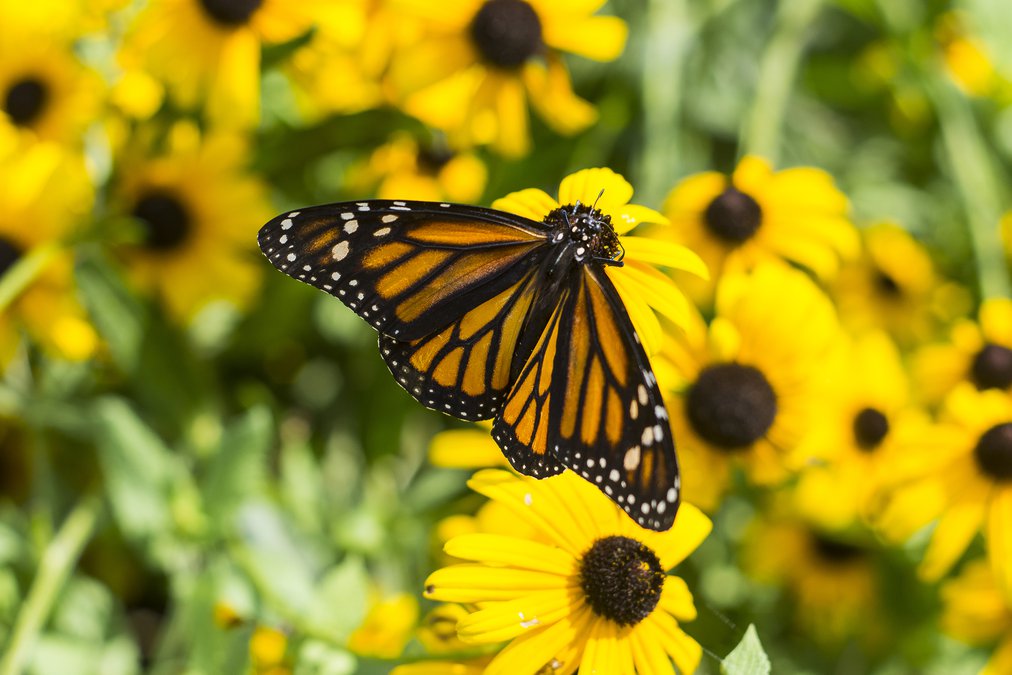Kansas Wetlands Education Center and the Quivira National Wildlife Refuge will both celebrate monarch butterflies this Saturday, Sept. 15, with free events.
The KWEC Butterfly Festival runs from 9 a.m. to noon at the Education Center, which overlooks Cheyenne Bottoms at 592 NE-156.
Quivira’s Monarch Mania runs from 9 a.m. to noon at the refuge’s Environmental Education Classroom, 1313A NE 140th Ave., rural Stafford. That is seven miles north of the Refuge Headquarters.
More than 600 people attended the KWEC Butterfly Festival last year, according to Mandy Kern, program specialist.
This year, the StoneLion Puppet Theatre will present an insect-themed puppet show. StoneLion is a Smithsonian Institute touring performer that uses multiple styles of puppetry, including marionettes, masks, shadow, mouth and rod puppets.
Those who attend either festival can capture and tag monarch butterflies. Nets and tags will be provided.
The “tag” is a sticker placed on the monarch’s wing, Kern said. Each sticker has a unique number that is entered into a database.
The Monarch Watch Tagging Program was initiated in 1992 to help understand the monarch’s fall migration. Each fall, MonarchWatch.org distributes more than a quarter of a million tags to thousands of volunteers across North America. The majority of recovered tags are found in Mexico.
KWEC Educator Pam Martin said they had nine tags recovered in 2015, six in 2016 and three in 2017.
“One recovered in 2015 in Mexico was tagged at St. John Preschool in St. John,” Martin said. “I’ve been giving them a tagging program for at least 20 years.
“And last year one tagged during a Salina High School field trip was recovered in Mexico,” she added. “It’s really by luck and by golly that a tag is returned, considering there are 100 million or more monarchs on the roost sites.”
According to a Quivira website sponsored by the U.S. Fish & Wildlife Service, a few of the monarchs tagged there most years are reported from their wintering grounds in Mexico. In 2016, staff and volunteers tagged 373 monarchs and nine were recovered in El Rosario, Sierra Chincua or Cerro Pelon, Mexico.
Last year, about 140 people attended Monarch Mania.
It’s really by luck and by golly that a tag is returned, considering there are 100 million or more monarchs on the roost sites.Pam Martin Kansas Department of Wildlife Parks & Tourism educator, Kansas Wetlands Education Center


Other activities
All ages are invited to participate in Quivira’s Monarch Mania, where they can learn about butterflies and see butterflies up close. There will be arts and crafts for kids, as well as face painting. A butterfly pavilion will be set up outdoors with live butterflies.
At the KWEC Festival, kids and adults will have the opportunity to make milkweed seed bombs and launch them into the prairie area using giant slingshots. Other activities include butterfly photo boards, insect zoo, crafts and door prizes.
The importance of milkweed
Monarch butterflies depend on milkweed for survival. As they migrate from Mexico to Canada, they lay eggs on milkweed plants. After the eggs hatch, the larvae feed on the blooming milkweed plants and mature to a butterfly in about six weeks. The newly emerged adult resumes the journey, laying eggs on milkweed plants along the way.
Monarch numbers have dropped, but efforts have been made to restore habitat for monarch butterflies and other pollinators.
Kansas is one of 10 states targeted as critical in supporting monarch migration. Farmers and ranchers are encouraged to make voluntary improvements that benefit monarch habitat. Natural Resources Conservation Service (NRCS) will provide technical and financial assistance to help producers and conservation partners plant milkweed and nectar-rich plants along field borders, in buffers along waterways or around wetlands, in pastures and other suitable locations. NRCS also help producers manage their pastures in ways that increase critical populations of milkweed and nectar plants while also improving the health of their rangelands. Producers interested in participating should contact their local USDA service center to learn more.
Many people now plant milkweed in their gardens. People who attend the KWEC Butterfly Festival will be given milkweed seeds that they can take home. They are perennial and can be planted in the fall.





